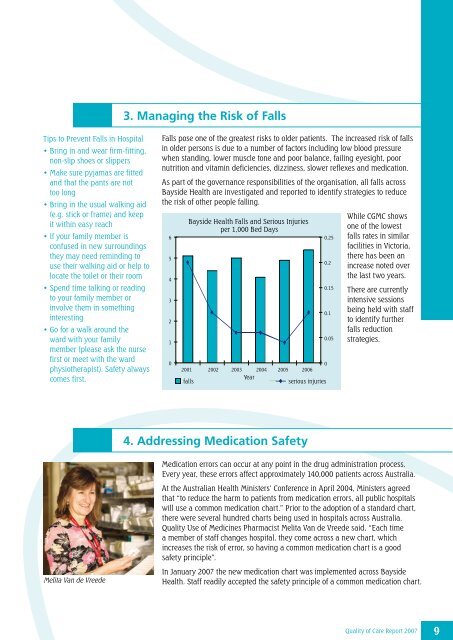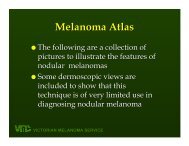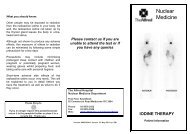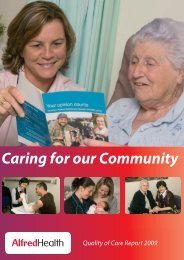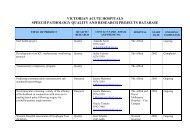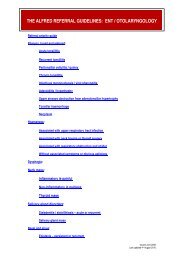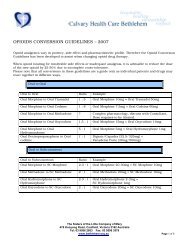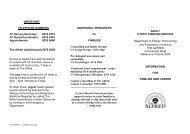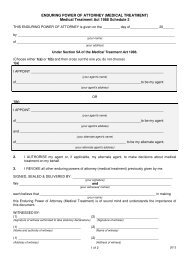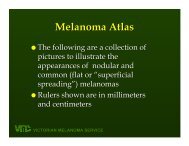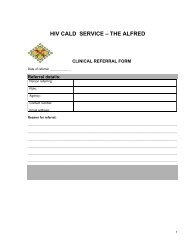Bayside Health - Alfred Hospital
Bayside Health - Alfred Hospital
Bayside Health - Alfred Hospital
- No tags were found...
You also want an ePaper? Increase the reach of your titles
YUMPU automatically turns print PDFs into web optimized ePapers that Google loves.
3. Managing the Risk of FallsTips to Prevent Falls in <strong>Hospital</strong>• Bring in and wear firm-fitting,non-slip shoes or slippers• Make sure pyjamas are fittedand that the pants are nottoo long• Bring in the usual walking aid(e.g. stick or frame) and keepit within easy reach• If your family member isconfused in new surroundingsthey may need reminding touse their walking aid or help tolocate the toilet or their room• Spend time talking or readingto your family member orinvolve them in somethinginteresting• Go for a walk around theward with your familymember (please ask the nursefirst or meet with the wardphysiotherapist). Safety alwayscomes first.Falls pose one of the greatest risks to older patients. The increased risk of fallsin older persons is due to a number of factors including low blood pressurewhen standing, lower muscle tone and poor balance, failing eyesight, poornutrition and vitamin deficiencies, dizziness, slower reflexes and medication.As part of the governance responsibilities of the organisation, all falls across<strong>Bayside</strong> <strong>Health</strong> are investigated and reported to identify strategies to reducethe risk of other people falling.6543210<strong>Bayside</strong> <strong>Health</strong> Falls and Serious Injuriesper 1,000 Bed Days02001 2002 2003 2004 2005 2006Yearfallsserious injuries0.250.20.150.10.05While CGMC showsone of the lowestfalls rates in similarfacilities in Victoria,there has been anincrease noted overthe last two years.There are currentlyintensive sessionsbeing held with staffto identify furtherfalls reductionstrategies.Melita Van de Vreede4500400035003000250020001500100068% reduction in people waiting for elective surgery4. Addressing Medication SafetyMedication errors can occur at any point in the drug administration process.Every year, these errors affect approximately 140,000 patients across Australia.At the Australian <strong>Health</strong> Ministers’ Conference in April 2004, Ministers agreedthat “to reduce the harm to patients from medication errors, all public hospitalswill use a common medication chart.” Prior to the adoption of a standard chart,500 there were several hundred charts being used in hospitals across Australia.Quality 0 Use of Medicines Pharmacist Melita Van de Vreede said, “Each time2001 2002 2003 2004 2005 2006 2007a member of staff changes hospital, they come across a new chart, whichincreases the risk of error, so having a common medication chart is a goodsafety principle”.In January 2007 the new medication chart was implemented across <strong>Bayside</strong><strong>Health</strong>. Staff readily accepted the safety principle of a common medication chart.Increase Emergency Department presentationThe <strong>Alfred</strong> 18% and SDMH 35%5000040000Quality of Care Report 2007 9


